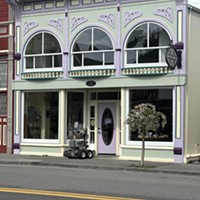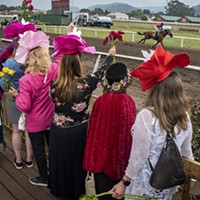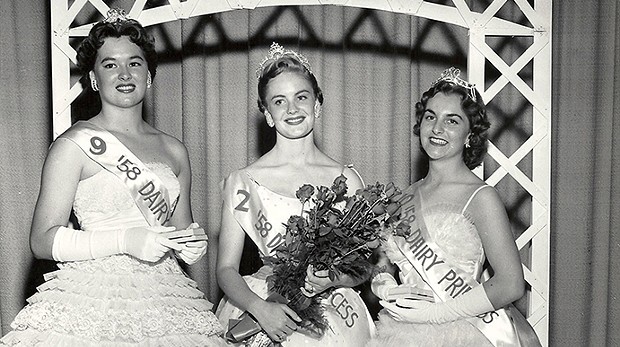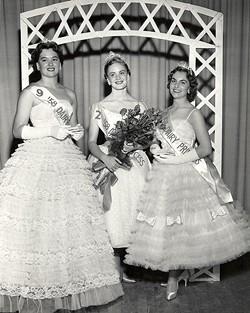[
{
"name": "Top Stories Video Pair",
"insertPoint": "7",
"component": "17087298",
"parentWrapperClass": "fdn-ads-inline-content-block",
"requiredCountToDisplay": "1"
}
]
There once was a little girl who dreamed of being a princess. A dairy princess.
One day this little girl was in her work clothes, cooking giant meals with her mother for the dairymen, throwing feed to the chickens, grooming her 4-H beast, or bucking hay, feeding calves and laying down clean straw in the milk barn. And the next day — shazam! — she was wearing a dress, sash and twinkling tiara and entrancing small children and big grown-ups alike with glasses of milk, scoops of ice cream and dollops of wisdom about why milk's good for you.
Where we live — in California's Dairy District 1, encompassing Humboldt and Del Norte counties — 56 dairy princesses have reigned since the American Dairy Association started the princess program in 1958. Hundreds of alternates have served right alongside them.
Princess schmincess, you say — we've got real, nonfanciful lives to lead here. Oh, but don't be too smug. Chances are, if you live in Humboldt, you know a dairy princess. And not just because you saw her serving ice cream at the county fair. You might have a princess for a boss. Or a teacher. A real estate agent. A nurse. An accountant. Maybe right at this moment you're tearing into a piece of grassfed beef jerky that a princess wrangled into existence.
A dairy princess is not, that is to say, a mincing, weak little frilly waiting in a constant faint for some big feller to come along and do the hard work. She'll do it, and do it well — that's how she became princess, after all.
How do we know this? Because we've talked with a lot of dairy princesses, including at least one from each decade of the contest, and we've learned a fair bit about the rest of them. The dairy industry may have changed through the years, but the princesses at their core remain the same: They're leaders. Teachers. Nurturers. Managers. And (mostly) they really, really love milk cows, or at least the people who tend them.
Also, in case you still want to sneer at the words "dairy princess," consider this: Up to 400 people have been known to pack the Fortuna River Lodge these days to watch young women compete for that sash and tiara. And for scholarships — this year's princess and three alternates split $10,000 among them.
Better get yourself a cow, girl.
Humboldt County has had a thriving dairy industry since immigrant farmers began settling with their cows in the Eel River Valley in the mid-1800s. In the 1950s, at the dawn of the princess era, there were hundreds of small dairy ranches here, most with a few dozen cows.
Joan Boynton Frakes, who was District 1's very first dairy princess, grew up on one of those dairies — about 150 acres of flat land settled by the Boynton family 100 years earlier along the banks of the Salt River, near Port Kenyon. The ranch is close to the ocean and often fog-enshrouded. Frakes (who now lives in Pullman, Wash.) remembers how, when the fog rolled back in the afternoons, she could see the ocean waves out the kitchen window. In those sunny hours the family would hurry to get the haying done so it could dry out.
Frakes' three big brothers — much older than she — helped their father with the haying, milking the Jerseys and other heavier duties.
"I could do whatever I wanted to do," says Frakes. "I got to feed the calves. I'd go down with my dad in the afternoons and bring up the cows. I could feed the dry cows — the ones not milking. Anything: Just to be outside on the ranch, that's what I loved to do. Mom, she was very busy always cooking; we had three huge meals, breakfast, dinner and supper."
When she turned 10 and was eligible to join 4-H, Frakes' dad let her go into the calf pen and choose one. She picked the one with a heart-shaped spot on her beige forehead, and named her "Hearty."
"I picked a winner, an absolutely beautiful animal," she says.
By her late teens, she had 15 dairy cows, including her "fancy cow," Hearty. They ran with the family herd, and Frakes showed them at fairs. Her dad showed some cows, too, and Frakes had to prepare all the show animals: trim their hooves, clip their hair and lay blankets on them to make them look smooth.
It was her mom's idea that she run in the new contest for a dairy princess. She was 19.
"It sounded interesting," Frakes says. "You had to have a dairy background. ... And it wasn't a beauty contest. That appealed to me. I thought that was really nice, something that wasn't based on beauty."
The contest and banquet were held in a conference room at the agricultural center on Humboldt Hill, and about 40 people watched Frakes and a few other girls vie for princess.
"I wore a silly brown wool dress that I made, just a very plain, figure-friendly dress," Frakes recalls. After she won, she went to the state contest in Los Banos, and there the contestants had to wear formals — layers of stiff, crinoline petticoats that made them look like sugary cakes. Hers was pink.
Jan Carlton, a Fresno State College student from a dairy in Winton, won state that year, and went on to compete nationally — where, apparently, beauty played at least a small factor. The 1958 American Dairy Association's contest program noted Carlton "is five feet six inches tall, weighs 120 pounds, and measures 36-24-36." Neither the national nor state contests exist anymore; the state contest ended in 1984 — the only year it was won by a Humboldt dairy princess, Bridget Enos Conner.
During Frakes' year-long reign as District 1 dairy princess, in which she also began her studies at Humboldt State, she spoke at service clubs, attended fairs, gave newspaper interviews and even had to handwrite milk-based recipes for local newspapers to publish. And she had to wear a sash, tiara and dress (nothing fancy) through it all.
Frakes left dairying after that. She taught at McKinleyville High School for a year, and summer school at Arcata High. Then she and her husband, Albert — a football player she'd met at HSU midway through her reign — began a family. He eventually got a job as an accounting professor at Washington State University in Pullman; Frakes stayed home to raise their three kids. Her nephew Matthew Boynton runs the family dairy ranch at Port Kenyon these days.
A succession of princesses followed. Over the decades, they have reflected the changes in Humboldt's dairying industry and in the times, while still evoking a hint of an earlier era,. Today, a dairy princess no longer has to live on a farm or have a father who runs a dairy. A grandfather dairyman or a dairy-related stint in 4-H will do. But every princess must be "wholesome": no live-in boyfriend, no husband and no children.
Every dairy princess we talked to — even the self-described shy or sheltered — said she emerged from her reign more self-assured and focused.
In 1969, another Port Kenyon girl won — 17-year-old Joanne Mendes (whose married name is Smith). That same year, the newly minted California Milk Advisory Board began running the state's dairy princess program. The state board is comprised of 24 dairy farmer-elected members from the state's 10 dairy districts. It's funded by a monthly assessment fee — today, the roughly 1,500 cow dairy farms in the state each pay 10 cents per hundred pounds of milk they sell.
Smith and her three brothers and two sisters all had chores growing up, taking care of 80 Guernsey milk cows and their calves, and a carrot crop on about 160 acres. "We cleaned corrals, milked cows, hauled hay and weeded carrots," she says.
They went to the Catholic Assumption School in Ferndale, where Smith played basketball, badminton and crab soccer. She was an outdoors girl.
"I did that princess thing for my parents," says Smith, who with her husband, Jack, owned Valley Grocery in Ferndale for 35 years until selling it in 2011. "They really wanted somebody to do that, to represent, so I said, 'Oh, OK, I'll do it, because I'm not going to win, so I'll just go do this one-day thing."
It was at the Eureka Inn. She wore bell-bottoms during the day for the interviews, and in the evening she put on a short, solid yellow dress her mom made for her. "Not a cocktail dress," she says. "It was very sweet."
They didn't announce the winner until 8:30 that night. She was shocked to hear her name. "I think it was because I was very genuine, very down to earth and practical," she says, self-consciously. "My parents were so proud, and that was the biggest thing. My dad had been through a lot. He lost all of his cows in the 1964 flood — 80 milk cows plus calves, so probably 100 animals. And in the 1955 flood, the water was up to the windows in our house. My dad worked and worked and worked and lost; worked and worked and worked and lost."
But the whole publicity thing, the traveling around to present ribbons and talk milk, wasn't for her.
"It was too much attention and time away from home, and I'm a home person," she says.
Before they bought the grocery, in 1980, she and her husband worked for Herb Russ' beef ranch on Bunker Hill. They raised two kids, who in turn raised 4-H animals on the couple of acres the Smiths owned. And for the past 10 years, Smith has been helping her friend, Mariett Dwight, run her grass-fed beef (and jerky) operation at Ridgetop Ranch, on Bunker Hill —"so I can keep my hand in doing something ranchy," she says. Just a couple weeks ago, they were up on Bunker Hill "preg-checking" cows. Her daughter married a local dairyman, and her son works for a construction company that has built a number of local milk barns.
The 1971 dairy Princess, Katherine Bryant (whose married name is Ziemer), then a 17-year-old Fortuna High senior, did not grow up on a dairy. Her dad — a logging truck driver — owned a dairy in Ferndale that was managed by someone else. That met the princess requirements. Ziemer also raised sheep in 4-H on her family's 2 ½ acres in Fortuna. They had a couple of horses and a few beef cattle. And she gained a little more dairy cred showing other kids' dairy cows in round robin events at fairs. She was, in fact (like lots of other princesses), a 4-H all-star — racking up awards for showing animals.
Ziemer wanted to be a dairy princess for a very precise reason — to learn how to be a public relations whiz.
"Being a dairy princess really is a public relations position," she says. "And I was really focused on looking towards some type of public relations/agricultural career."
Maybe the three judges looked into their milky ball and saw she wasn't kidding — that she would spend 10 years doing publicity and superintending the livestock for the Humboldt County Fair before settling in for 24 years (and counting) at the helm of the Humboldt County Farm Bureau. She's the executive director.
Ziemer keeps her tiara in her china cabinet. And she and her husband, retired Humboldt Fire Protection District Chief Glenn Ziemer, have good-natured battles over who gets to drink straight from the milk jug.
"We buy three gallons a week and Glenn drinks most of it," she says, and adds, laughing, "I try to get him to pour it into a glass — and then he sees my lipstick on the jug, and he gets a glass."
As the dairy princesses exchanged their bell-bottoms for bootcuts, the dairy country they once knew was being transformed. In 1981 there were still 161 dairies in Humboldt, according to Mary Ann Renner, who is dairy through and through: She grew up on her dad's dairy in Ferndale, vied for dairy princess when she was in high school, and married a dairyman, Dave Renner. Their daughter, Alayna, was dairy princess in 2008. Mary Ann Renner has coordinated the local dairy princess program since 1993, and in that time she has seen the number of dairies just keep dropping.
By 2007, Humboldt had 90 dairies, according to a report by the Prosperity! group. By 2012, there were just 64, according to the state Department of Food and Agriculture.
Dave Renner says it's happening everywhere, not just in Humboldt County. Dairies are consolidating, their larger herds upping per-farm production; machinery's getting more efficient, upping per-cow milk production.
"Efficiencies of size and scale — you have to get larger in order to become more efficient and more competitive," he says.
Gone, mostly, is the 40- to 80-cow herd. The Renners have 350 milk cows, plus calves. The state reports that the county's 64 dairies average 217 cows each. A few are much larger, with 800 or more. (Even so, Humboldt's dairies remain comparatively small, averaging one-fifth the size of dairies statewide.)
Small or large, though, dairying takes work. Linda Fraga Sturges — 1982 dairy princess — saw enough of that firsthand. She grew up on her family's dairy farm, the Masada Dairy, on 80 acres they rented in the Arcata Bottom. She had nothing to do with the cows. Or 4-H or Future Farmers of America. In fact, as a young girl, she vowed to herself she would get as much schooling as she could to get off the dairy.
"I saw how hard my parents worked," says Sturges. "My mother worked full time outside the home, as head of housekeeping at the Ramada Inn in Valley West, and then full time at the dairy cooking a big breakfast and the other meals." Her father worked tirelessly outside.
Sturges and her mother did the "inside work." Her parents had emigrated from the Azores in 1959, and kept a traditional household. Sturges had to feed the chickens and collect eggs, make blood sausage, and help her mother cook meals, wash dishes, do laundry and clean the house. In her senior year of high school, she also started working at the Ramada Inn.
One day, she says, another dairy rancher knocked on the family's front door and asked her father if he would buy some tickets to the dairy princess banquet. Her father asked what that was. And then he demanded to know the requirements — could his daughter compete?
"Nobody even knew the Fragas had a daughter," says Sturges. Two days later her mom said to her, "'You're going to put on a dress and go to this thing at the Eureka Inn.'"
It was less than two weeks away. Her parents didn't let her date, so a coworker at the Ramada agreed to escort her. She wore a mid-length, cream-colored, demure dress with long sleeves and lace up to her neck.
Silvia Leonardo, who was the dairy princess coordinator at the time, remembers how Sturges' speech, delivered rapidfire in precise, accented English (Portuguese was her first language), "blew everyone out of the water." Neither she nor Sturges recall the content, but Sturges says she probably talked about her parents being immigrants and scraping up a living as dairy people in their adopted country.
As dairy princess, Sturges discovered she had a knack for public speaking. "That experience alone prepares you for any interview you're going to have," she says. "You learn to shake someone's hand, look them in the eye."
She graduated in 1988 from HSU with a degree in business administration and a minor in computers, spent 13 years traveling the country helping companies automate their cable systems, then traveled throughout Asia for Intel several years doing the same work. She got a master's degree in education. She wound up in banking, then was caught up in massive recession-triggered layoffs in 2008. She is divorced now, living back in Humboldt County, raising her daughter (who is 16) and working as an invoice associate at Walmart — on track, said a recent shareholders' letter, to be an assistant manager.
Sturges' brother, Mike Fraga, stayed with the milk industry — but switched to goats, she says, "because cows are so expensive."
Sometimes, dairy princesses grow up to be dairywomen.
In 1991, the tiara went to Debra Holgersen (married name Nickols), whose great grandparents emigrated from Denmark in 1908 and established a dairy at Beatrice, where Tompkins Hill Road and Hookton Road intersect. A dozen little dairies had sprung up around Beatrice, and they all sold their milk to Eclipse Creamery. Her family's dairy — Holgieville Jerseys — is all that's left there now.
At 19, Nickols was a jeans-and-cowboy boots girl, an "aggie girl." But she dreamed of being a dairy princess — not just because of the scholarships, which District 1 had begun offering in 1985, but because she really wanted to meet the other dairy people and to takes calves into elementary schools to teach kids about the dairying life. And serve ice cream.
"My favorite thing to do was scooping ice cream at events," she says.
She even did a TV commercial once with Harvey Harper, the late patriarch of Harper Motors — she and he sat in an old-fashioned, yellow Ford in a field, surrounded by her milk cows.
Nickols married, started a family, worked for a vet and then was lured back into dairying. She's worked for her dad since 1999 at Holgieville Jerseys and today is the herd manager.
Other princesses have gone on to become insurance agents, nurses, loan officers and a plethora of teachers — of art, music, home economics, accounting, business and, especially in the past couple of decades, agriculture science, business and economics. Farm-bred or not, they share one defining characteristic: They're dedicated, hard-driving achievers, as princess coordinator Renner puts it.
In 2003, the 17-year-old daughter of a park ranger mom and fire captain dad became dairy princess. Jalisca Fry (married name Thomason) was in FFA, and her parents let her raise dairy heifers and goats and sheep on their five acres in Bayside. (Her mom grew up on a goat dairy, in another part of the state — but the California Milk Advisory Board doesn't represent goat dairies.)
Thomason says she was eager to interact with dairy producers and consumers, and to advocate for them — something she does to this day as a high school agricultural teacher and head of the ag department at Woodlake Union High School near Visalia in the Central Valley.
"I feel that there's a big disconnect between what the producers know and what the consumers assume," she says. "For example, producers know that everything they do is for the benefit and health of the animal. And consumers feel that dairy animals aren't always treated appropriately and that antibiotics are used indiscriminately — and that's not true."
Thomason, who studied at Cal Poly, San Luis Obispo (a favorite college choice for local dairy princesses, along with U.C. Davis), says today's dairy princess need to be armed with a lot more than ice cream scoops, chocolate milk cartons, basic dairy facts, ribbons and smiles. Even the cute calf that a princess trots into classrooms for kids to meet isn't enough. (Thomason recalls that her calf pooped all over Mrs. Branca's floor.)
"Dairy princesses today should be a lot more informed about animal health and antibiotics," she says. "They should be up on legislative matters, and know how milk quotas are established."
Today's princess might want to be up on changes in local dairying, too, including the biggie: District 1's major shift to organic milk production, which Thomason approves of. The feed costs more, but the product sells for more. And Humboldt still has the land — and an ingrained family dairy tradition — to do it. Most of the dairies have made the switch, and now 70 percent of milk production from Humboldt and Del Norte counties is organic, says Blake Alexandre, who runs organic dairies in both counties.
It's a tall order — the milk quota thing alone is headache-inducing.
But the 2013 dairy princess, 17-year-old Andrea Guggenbickler, seems plenty smart for the task. The Ferndale High School junior had a 4.4 grade point average last semester. She's got the new-rules dairying cred in spades: She grew up in town in Loleta, but worked for her grandpa, Larry Nicholson, on his dairy on Grizzly Bluff — tending calves and dry cows, driving the six-wheeled Gator and the tractor, slinging 70-pound bales of hay, moving fence, and rounding up cows at milking time. She's also been raising heifers for 4-H since she was 9, and she raised chickens with FFA. She's done a lot of public speaking, too, and this summer she went to Girl's State in Claremont. Guggenbickler is pumped about being dairy princess, and about the "extremely wonderful" week of princess training she attended in Modesto.
"It was so nice to meet all the other girls from the other districts, and to see they're the same as you, that they're of the same mindset. Everyone is focused on the goal of advocating for the dairy industry, because they love the dairy industry. Everyone is in love with the dairy industry, just like you."
She and her alternates have quite a few plans for the rest of their year-long reign, which began after they were selected in May. Besides speaking engagements, school visits and serving ice cream, they're talking about having a dairy day at the park in Ferndale and bringing calves and milking cows.
And when it's over? Guggenbickler hopes she's headed for U.C. Davis — to study forensic chemistry so she can eventually become a medical examiner. Yep, as in CSI, although she realizes it's not as exciting as on TV.
"I've already been to the cadaver room at College of the Redwoods, to see if I could handle it," she says. "It wasn't a big deal."
In the meantime, going around in that tiara and sash, talking about living healthfully and including milk products in your diet, she might give some other little girl (or her parents) an idea about becoming a princess.
A dairy princess.
•
Speaking of...
-

UPDATE: Artillery Shell Deemed Safe in Ferndale
Apr 12, 2024 -

Spooky Trains, Sketchy Books and Ballot Initiatives
Oct 24, 2023 -

Photos: Ladies' Hat Day at the Races
Aug 29, 2023 - More »
more from the author
-
From the Journal Archives: When the Waters Rose in 1964
- Dec 26, 2019
-
Bigfoot Gets Real
- Feb 20, 2015
-
Danger at McCann
A kayaker's death has raised safety questions about low-water bridges
- Feb 19, 2015
- More »
Latest in News
Readers also liked…
-
Through Mark Larson's Lens
A local photographer's favorite images of 2022 in Humboldt
- Jan 5, 2023
-
'To Celebrate Our Sovereignty'
Yurok Tribe to host gathering honoring 'ultimate river warrior' on the anniversary of the U.S. Supreme Court ruling that changed everything
- Jun 8, 2023

































